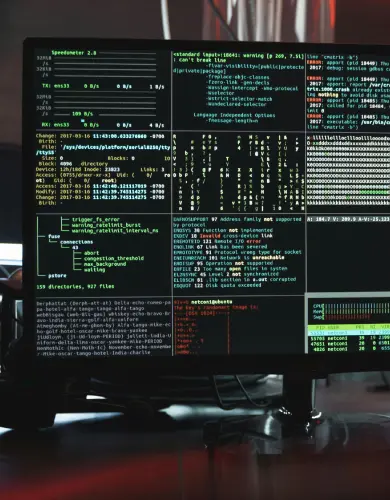FTTP vs FTTC for businesses
Openreach and others have been steadily laying new fibre optic cables across the UK, taking average internet speeds in the UK into all-time highs. But while fibre optic cables reach all the way into business premises, some only arrive at the local street cabinets, creating two broad types of fibre optic broadband: FTTC (Fibre-to-the-Cabinet) and FTTP (Fibre-to-the-Premises).
This article compares these two types of fibre optic connections in speed, performance, availability, and costs, i.e., FTTP vs FTTC.
💡 Key takeaways:
- Speed and Performance: FTTP is faster and more reliable than FTTC because the fibre cables cover the entirety of the connection, leaving no bottlenecks due to a slower tether.
- Availability: FTTC is pretty much ubiquitous, while only around 60% of properties can access FTTP. Find out if full-fibre is available to your business.
- Alternatives: If fibre optics or cable broadband does not serve your business property, opt for satellite internet providers like Starlink.
What’s fibre broadband?
Let’s begin with the basics. Fibre-optic technology uses light signals to transmit data over thin strands of glass or plastic, offering unparalleled business broadband speed, latency and reliability. These strands are stuffed into cables covered with a sheath to make them look like any other telecoms cable.
Fibre optics are replacing the older telephone copper wires, which are slower and less reliable at transmitting data. This big infrastructure overhaul is still a work in progress, though, and many places remain copper-dependent (this is called ADSL broadband).
So when providers refer to fibre optic broadband, they mean any broadband connection that uses fibre-optic cables at any point on its journey between your router and the nearest Internet Exchange Point (i.e. a physical internet junction where all connections join), fand not necessarily the whole way.
Therefore, copper wires can partially cover fibre connections and still be called “fibre broadband”. This is where FTTP and FTTC come in, creating this distinction.
💡 Procurement: Business broadband providers often avoid these terms and simplify them into “superfast” and “ultrafast” broadband, depending on the speed. But FTTC and FTTP also differ in reliability and security, so doing research before procuring a business broadband deal is paramount!
Let’s take a look at each in turn:
What is FTTP broadband?
FTTP stands for fibre-to-the-premises, where the fibre cable reaches all the way from the nearest exchange to your business broadband router. No old-fashioned copper cables slow down your connection.
In other words, data flow from your Zoom meeting or into and out of the cloud is occurring near light speed within the tethers, giving rise to the name “ultrafast” broadband that is alternatively used for FTTP (also known as FTTH (Fibre-to-the-Home) in residential broadband).
💡 Read our detailed guide on full-fibre business broadband to learn more.
What is FTTC broadband?
FTTC stands for Fibre-to-the-Cabinet, with the “cabinet” being a green box housing telecoms equipment usually found on a nearby pavement.
In this setup, the remainder of the journey from the cabinet to your business premises is covered by your copper telephone cable, which is convenient but significantly less performant. thus creating a traffic ‘bottleneck’, just like when a fast motorway merges into a smaller road.
FTTP vs FTTC
Here are five key differences between FTTP and FTTC broadband:
Speed: Full-fibre (FTTP) is faster than FTTC
FTTP is typically much faster than FTTC because no old-fashioned copper cables slow down the internet connection. Generally speaking:
- Typical FTTC speeds: 35 – 76Mbps (excluding Virgin Media‘s cable broadband and GFast).
- Typical FTTP speeds: 60 – over 1,000 Mbps.
💡 Overlap: Notice that there is speed overlap between them. This is mainly because providers can set ‘speed limits’ depending on the chosen package. However, even a faster FTTC connection is less stable and secure than a slower FTTP connection.
Availability: Full-fibre (FTTP) is not always available
Both types of fibre broadband require that your business premises are in an area where fibre optic cables are installed. This is an ongoing challenge for businesses in rural locations.
However, FTTC broadband is more widely available, as it is much more convenient and impactful to improve the connection to multiple homes and businesses at once rather than one-by-one, improving the final bottleneck. This is obvious from the figures:
- FTTC broadband is available to 95% of properties.
- FTTP broadband is available to 60% of properties.
Source: ISPreview H1 – 2023, ISPreview H2 – 2023
💡Satellite internet: Many rural properties in the UK can find better performance from a satellite internet connection, such as Starlink or OneWeb, than waiting for the roll-out of even part-fibre to their properties. Thinking of farms, outdoor cabins, fieldwork crews, etc.
Costs: Full-fibre (FTTP) is more expensive
FTTC is cheaper than FTTP because there is no need to do any engineering work to install a fibre cable into your business, as it will utilise the existing telephony copper wires. For this reason, premium FTTC packages tend to be cheaper than the cheapest FTTP packages, and often deliver better speeds.
However, with the growing reliance and sophistication of the internet, the opposite is likely true in the long run. Businesses require modern digital tools to remain relevant, and at some point, copper cables will become insufficient to support even the minimum requirement for basic tools. An upgrade in the fibre will be necessary at some point, so avoiding it is simply leaving a to-do for the future.
Also, considering the superior reliability and security of FTTP, it may end up saving you money now simply from business efficiency (i.e. your website will be down less often).
For more information, please review our business broadband prices page.
Installation: Full-fibre (FTTP) requires engineering work
Since FTTC fibre broadband uses existing copper telephone wire lines, switching to FTTC broadband does not require any intervention from engineers. If you’re switching from ADSL broadband, you may need a new router and modem that supports the more advanced technology.
In contrast, FTTP requires an engineer to install a fibre cable between the local exchange or cabinet and your business. This work may need planning permission, including digging trenches and drilling holes through walls.
💡 How to switch: Use our step-by-step guide to switching business broadband providers for more information on how to switch between any technology.
Reliability: Full-fibre (FTTP) is more reliable
FTTP is more reliable simply because fibre optic light signals are harder to interfere with than the copper wire electrical pulses used in the copper wire segments of FTTC. Anything from electrical storms to magnets can interfere with the flow of electricity, reducing its stability and even making it prone to malicious interference or data losses.
FTTP is fast; FTTC is cheap
The advantage of full-fibre (FTTP) is undeniable. It’s more performant in almost all metrics and provides a better user experience, regardless of what your business does. It also future-proofs your business as up-and-coming web 3.0 applications will rely on the constant data stream to feed its algorithms.
But of course, all of these advantages come at a cost. The engineering work required and the higher monthly fees will cost your business more in the short to medium term, so it’s really up to your business needs (and if the service is available in your local area!)
If your business is largely analogue or if you’re on a low budget, a cheap broadband deal supported by FTTC may suffice!
FAQs
Our business broadband experts answer commonly asked questions on FTTP vs FTTC in the UK.
What speeds can I get with FTTC?
An FTTC connection’s download speed is typically between 35 and 76 Mbps, depending on factors including your fibre broadband deal, location, the distance between your router, cabinet and nearest exchange, and the state of repair of your cables, just to name a few.
There are also two key exceptions:
- GFast broadband is capable of greatly improving FTTC speeds to 330Mbps! This technology is available to 2.8m business properties in the UK but has been discontinued as it is ultimately incompatible with the roll-out of fibre optics.
- Virgin Media broadband doesn’t use the Openreach network but instead uses a faster type of cabling for its FTTC servicing, allowing much faster speeds.
What speeds can I get with FTTP?
The download speed of FTTP fibre broadband packages can range from as little as 50 Mbps (fast) all the way to 10,000 Mbps for a bespoke full-fibre leased line.
On average, our experts estimate this speed is in the mid-100s of Mbps, depending on various factors. See our detailed guide on full-fibre business broadband for more information on FTTP speeds.
What’s more expensive, FTTP or FTTC?
Generally speaking, FTTP is more expensive as it requires installing and maintaining a dedicated fibre line into your property.
It depends on which broadband provider and packages you choose, but generally speaking, an FTTP broadband connection can be as much as 50% more than an FTTC connection.
Can I get FTTP broadband?
This depends wether the fibre optic cable network has been laid out in your area. Openreach is working hard to deliver an FTTP broadband service to 25 million properties by 2026.
Openreach keeps an up-to-date map showing the progress of the full fibre roll-out.
Even better, here’s an address finder tool to get your business’s FTTP and FTTC availability.
Should I choose FTTP for FTTC for business broadband?
Our business broadband experts recommend that your decision be based on the availability at your commercial property address. If your business has access to a full-fibre (FTTP) connection, you should take a full-fibre business broadband deal.
In a full-fibre business broadband deal, the connection quality will be much higher without costing significantly more than an FTTC connection (The cost-benefit tends to be very favourable!)
Who does FTTP in my area?
Type in your business postcode into our simple business broadband comparison tool to see if FTTP (ultra-fast broadband) is available in your area.
When is FTTP in my area?
You can find out when FTTP may reach your area by using this up-to-date map showing the progress of the full fibre roll-out.
Is FTTP the same as VDSL?
No, FTTP (Fibre-to-the-Premises) and VDSL (Very High-Speed Digital Subscriber Line) are not the same.
FTTP involves running fibre optic cables directly into the premises for high-speed internet, while VDSL is a type of DSL technology that uses copper lines for the final connection to the premises.
FTTC vs FTTP vs FTTH
FTTP (Fibre-to-the-Premises) and FTTH (Fibre-to-the-Home) are essentially the same thing, except that FTTP applies to any kind of property (incl. commercial and institutional) while FTTH applies only to households.
It is when the entirety of the physical tether between the internet exchange and the property’s router is covered by fibre-optic cables.
FTTC (Fibre-to-the-Cabinet) involves fibre optic cables from the internet exchanges to street cabinets, then copper lines to the premises.

